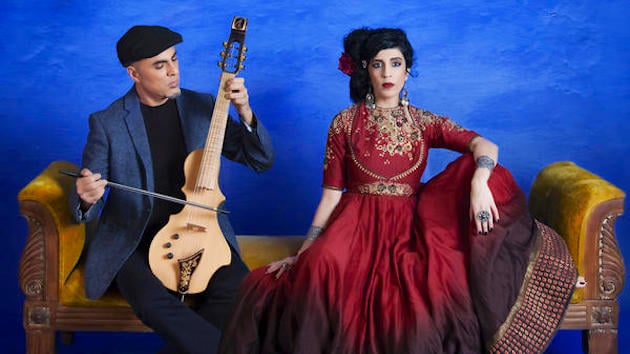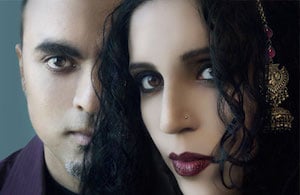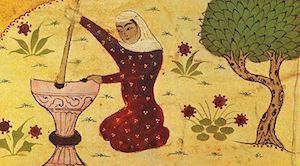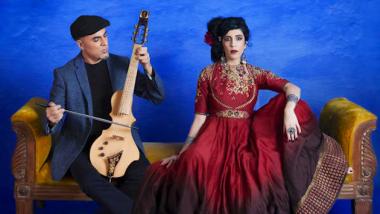
Blending Middle Eastern and Persian music with state-of-the art electronica, Niyaz (which means yearning in Persian, Urdu, and Turkish) has created an entirely new experience with their latest endeavor, “The Fourth Light Project.” Cofounded in 2004 by Iranian-born vocalist Azam Ali and her husband, Iranian-born multi-instrumentalist and composer Loga Ramin Torkian, their music, which they describe as postmodern Middle Eastern, bridges their Iranian roots with those of the American culture they have lived in for many years.
“The Fourth Light Project” is a mesmerizing, immersive multimedia production combining the ensemble’s rich and riveting electroacoustic music with a spectacular display of cutting-edge, interactive visual effects, created by acclaimed designer/visual artist Jerome Delapierre. The show is dedicated to Rabia Al Basri, the first female Sufi mystic and poet who lived in the 8th century. They will be presenting it on Thursday, Feb. 20, at the Green Music Center in Rohnert Park.
Ali and Torkian met in the ’90s in L.A., where a rich and diverse global music scene was developing, including a group of Iranian immigrants who were beginning to experiment with fusing traditional Persian folk music with modern American styles and technology. At the time, Azam was working with Vas, the alternative world music group she cofounded in 1996 with American percussionist Greg Ellis, and Torkian was working with Axiom of Choice, the Persian and Middle-Eastern group he started with singer Mamak Khadem. Since forming Niyaz, they have recorded four albums and toured worldwide.
Ali spent many years in an English boarding school in India, assimilating the culture and its music. She came to America in 1985 as a teenager, and studied the santour (a Persian hammered dulcimer) and trained in Western classical as well as Indian, Persian, and Eastern-European vocal techniques. Her voice can be heard on the soundtrack of several major Hollywood films and television shows, including The Matrix Revolutions, Prince of Persia, Thor: The Dark World, and True Blood.
Torkian, who also moved to the U.S. as a teenager after the Iranian Revolution, is a composer and master of many different instruments, including the Turkish saz (a long-necked string instrument), the kamaan (a bowed acoustic instrument), and the guitar viol (a 14th-century European bowed guitar). He has composed music for a number of popular movies, including Iron Man, Deception, and Body of Lies, and has received numerous accolades for his ability to create inspired contemporary pieces from traditional Persian themes and rhythms.
I spoke with them by telephone from their home in L.A. about what their personal and musical journey has been, and what inspires them to create this unique cross-cultural blend of music.
What was the inspiration for Niyaz?
Ali: It was really born out of a desire to merge the past and the present between East and West. It wasn’t such a conceptual thing, it was much more autobiographical in the sense that we wanted to blend our culture that we came from with the culture that we were living in now.
Did being in America affect the creation of or inspiration for the music?

Torkian: Yes, absolutely. Listening to Western music is something that you kind of grow up with, because the cultural influence of the Western world is huge everywhere. But then when you come here, there is a whole other level of experience and interaction with the culture and the music that you internalize, and inevitably begins to become part of your expression, and you want whatever you create to include that.
A perfect example of that is that in classical Iranian music, you really don’t have anything in the bass range. The lower instrument is the oud, which is the equivalent of a baritone sound in a Western classical context. Not having that spectrum of sound in the music, you feel a sense of void. So you naturally want to fill it up with something, and get attracted to the kind of sounds and styles of music that have that in it, and you want to incorporate that into your work. That’s one of the reasons that incorporating electronic music into our sound was exciting.
Your music is a blend taken from many countries. What is the commonality?
Torkian: I think one of the things that is very fluid is the improvisational factor. It’s the kind of music that is based on a lot of small themes that you expand and improvise and create additional melodies with. But we are particularly focused more on folk music, and a strong part of the musical structure of folk music is the rhythm. And more than anything else, I think that the human story, the human struggle, has not really changed in centuries, so a lot of the poems and lyrics still resonate, no matter how many years have gone by or how much technology has advanced.
Did you write original lyrics for “The Fourth Light Project”?
Torkian: For “The Fourth Light Project,” we did write some original lyrics based on Rabia’s work, because this album is a tribute to the first female Sufi of the region, and in many ways we consider her to be the first feminist of the region. We tried to use her poetry as it was written, but unfortunately there were not that many that could be verified to be truly hers. So what we decided to do was to use it as inspiration and write our own lyrics based upon her work.
What made you decide to base this music on the Rabia?

Ali: She is actually the mother of Sufism, but was left out of our history books because she was a woman, so it really came out of a desire to shine a spotlight on her. Even Rumi and other famous Sufi poets that came after her had written poems about her. For me as a woman, she represents the fact that she was, in her own time, a feminist, and did not fit into the traditional role of a woman. And her life story was very interesting in many ways. She didn’t get married and have children and stay home. She became a poet and a mystic and lived a very unconventional life. So I think especially in the time we are living in, it’s really important to shine a light on these historical figures.
Why did you decide to use a female whirling dervish in the show?
Ali: We did that on purpose because in the show, in many ways, both myself and the whirling dervish represent the spirit of Rabia. It’s also one more way of breaking tradition and norms.
Is “The Fourth Light Project" different from other albums and projects you have done before?
Torkian: Yes. One of the things that is most different about it is that we actually did write it with the intention to make it a multimedia project. So what we are bringing onstage is not just a concert, it actually has a very strong visual component to it. Another thing that is very different is that this is the first album that Azam did the electronics for, so it is much closer to what we always envisioned.
How did your collaboration with Jerome Delapierre come about?
Torkian: We moved to Montreal between 2009 and 2016 and Jerome is a well-known digital artist there and that’s where we met him. We already wanted to do a multimedia project and it took us many years to find the right partner. But when we met, we knew that he was the person we would do this project with. He was equally excited, and the outcome is really stunning. People that come to the show are just blown away.
The visual effects are described as interactive. What does that mean?
Torkian: All of the visuals interact either with the music or the movement onstage. That’s the element that makes it interactive. So if somebody plays something onstage in a certain spectrum of frequency, the visuals are going to change. In a conventional concert, it’s usually the bass or the kick drum that drives all the lights onstage, but when you have more complex and sophisticated mapping of sound, then you can break it down into a different frequency and spectrum so it interacts in a much more sophisticated way.
Ali: It is something people do not expect because it’s interactive and there’s a lot of body mapping and sound reactive elements to all the visuals, so everything is very synchronized and it creates an incredible synergy onstage.
Do you feel like what you are doing is bridging the gap between cultures?
Ali: Absolutely, but I don’t think just our performances are going to change hearts and minds. This is why we do residencies and artists programs, because I think you have to really educate people on a deeper level. No one is going to have their minds changed just because they came and saw a concert. The education part is incredibly important for us.
What do you think sets Niyaz apart from other groups?
Ali: During the time we began this type of music, there were several other artists who were already experimenting with this sound, but no one really in the Iranian music scene. Many people consider us pioneers at creating a very new sound for this kind of music.
Do you have anything lined up for the future?
Ali: As we are touring the “Fourth Light,” we just finished the synopsis for our next show. We are going to stay within the immersive, multimedia stage production, so it’s going to take us at least a year to produce the music and create the new show.
What does creating and performing this music do for you?
Ali: I think it’s what it does for any artist — you express something very deep in yourself. Hopefully, you are creating some sort of transformation within yourself and that you can then project outwards and transform other people’s lives who are experiencing it.




